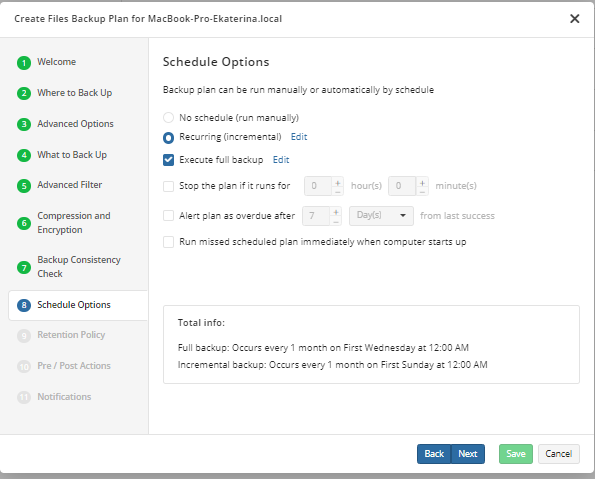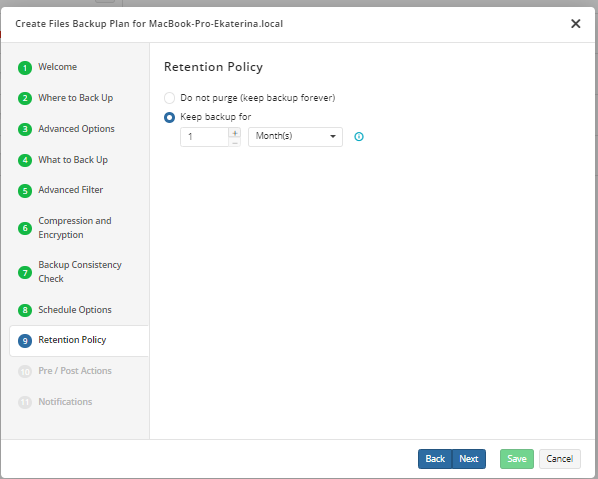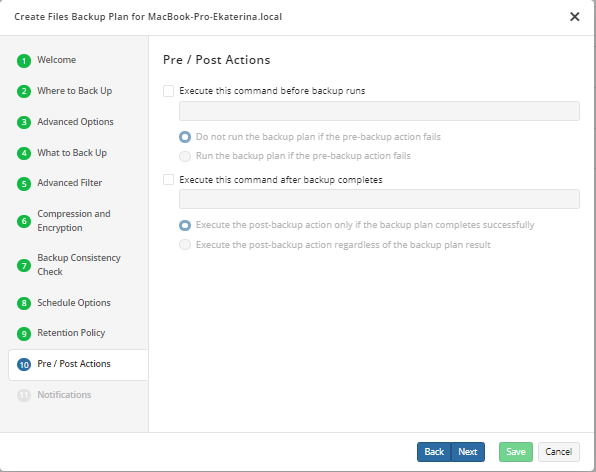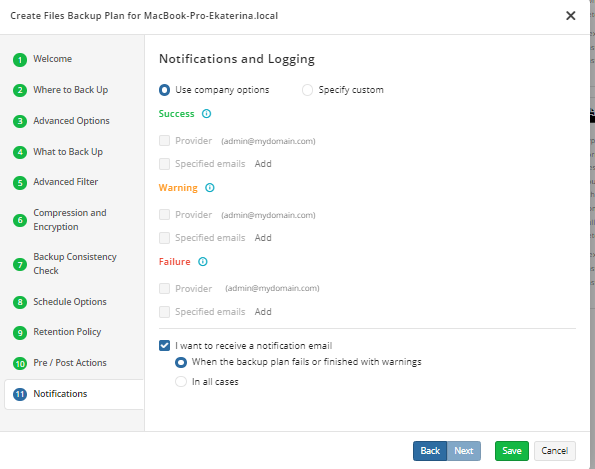File Backup (new backup format)(BETA)
Use the remote management tools to create file backup plans in the new backup format on remote computers.
This chapter covers the following topics:
- File backup plan overview
- Create new file backup plan
- Run the Backup Plan
- Edit the Backup Plan
- Clone the Backup Plan
- Delete the Backup Plan
File Backup Overview
The new backup format introduces the following features for MacOs based environments:
- Client-Side Deduplication
- Consistency Checks
- Restore on Restore Points
- Optimized operations with storage, resulting in fewer requests, faster synchronization, and faster purge
- Continued data upload in case of network issues
- Object size up to 256TB to any storage destination
- Optimized performance and storage usage for a large number of small files
- Improved incremental backup performance.
Required License: Any valid backup agent license (To learn more, refer to Backup Agent License Types)
Create New File-Level Backup Plan
- On Computers select Remote Management if you use legacy main menu, or open Backup > Computers page in the new main menu.
- Find the required computer, then click the Configure icon in the Backup Plan Status column.
- On the side panel, click + or +Add New Plan.
- In the drop-down menu, select Files Backup plan (NBF) (Beta).
- Once you are finished with the plan settings, as described below, click Save.
Plan Name
Name the backup plan on Welcome page.
In the new backup format, a backup plan configuration is always saved in a backup storage
Click Next to proceed.
Where to Back Up
Select a target backup storage for the backup plan. If no storage accounts are available, create a new one. Refer to Add New Storage Account to learn how to do it.
Once you selected backup storage, click Next.
Advanced Options
Specify advanced options for the backup plan.

Custom Options for Amazon S3
If your backup destination is Amazon S3, the following custom options are available in this step.
- Use S3 Transfer Acceleration. Use this option to accelerate file transfer for an extra fee. The target bucket must have this feature enabled
- Select the S3 storage class for the backup plan:
Using different storage classes for different backup purposes helps you to optimize the storage costs.
Learn more about Amazon S3 storage classes here
Custom Options for Microsoft Azure
If your backup destination is Microsoft Azure, select the required Azure Blob Storage.
The following options are available:
- Archive Blob Storage. This is a low-cost storage option for infrequently accessed data. As opposed to hot and cool storage tiers, retrieving data from an Archive Blob Storage may take up to several hours
- Cool Blob Storage. The cool storage tier has lower storage costs and higher access costs compared to hot storage. This tier is intended for data that will remain in the cool tier for at least 30 days
Note that this feature is only supported for General Purpose v2 Azure accounts. If you are using another kind of account, you need to upgrade your account to be able to use this feature
Be aware of the additional charges and increased blob access rates after your Azure account upgrade
To learn more about the difference between Azure storage tiers, refer to the Azure Blob Storage - Hot, cool, and archive storage tiers article at docs.microsoft.com.
What to Back Up
Specify files and folders to be included in the backup plan.
| Check Box Appearance | Description |
|---|---|
 |
This folder with all subitems excluded. All new content will NOT be added |
 |
This folder with all subitems included. All new content will be added |
 |
Specific items excluded. New content be added, except for updates for excluded items |
 |
Only selected items included. New content will be NOT be added, except for updates of included items |
Click Next.
Advanced Filter
You can configure the criteria to include or exclude files/folders to backup.
Back up all files in selected folders. Select this option to back all files in folders, specified in the Backup Source section
Back up files of specified types. Select this option to back up files of certain types. The file type is detected by file extension. In the field below, specify the required file extensions
Do not backup files of these types. Select this option to exclude files of certain types from the backup plan. The file type is detected by file extension. In the field below, specify the required file extensions
Skip folders. In this field, specify folders to be excluded from the backup plan. Separate them with semicolons
Back up empty folders. Select this check box to include empty folders in the backup plan
Do not back up system and hidden files. Select this option to exclude files that have 'system' and/or 'hidden' attributes from the backup plan. Refer to System and Hidden Files Backup for details
Click Next.
Compression and Encryption Options
Specify compression and encryption options for the backup plan.
The following options are available:
Select the Enable compression check box to compress backup contents to reduce the backup size on storage
To protect your backup contents with encryption, select the Enable encryption check box. The following AES encryption bite key lengths are supported: 128, 192, and 256. Select the appropriate key length in the Algorithm drop-down menu
Specify the encryption password in the Password field, then confirm the password in the Confirm field. Mind keeping the encryption password in a safe place. Pay attention, if Password Recovery Service is not enabled in the Management Console, then if the encryption password is lost or forgotten, the encrypted backup cannot be restored.
In the Hint field, specify some information that could help to recall the password in case you forget it
Use Server Side Encryption. Select this check box to enable encryption of your backup content if you use Amazon cloud storage. Note that the user should have enough permissions to access backup data.
Click Next.
Full Consistency Check
Configure the full consistency check for the backup plan.
Full consistency check implements checks of data integrity for all generations (full and incremental backup sequences) except for the current generation check, which is the subject of a mandatory consistency check. A mandatory consistency check is performed at each backup plan run.
After the successful full consistency check, the backup data can be guaranteed to be restored.
Click Next.
Schedule Options
Specify the backup plan schedule settings.

The following schedule options are available:
The following options are available:
- Select the No schedule... option to run the backup plan manually
- If you want the backup plan to run incremental backups on a constant periodic basis, select the Recurring (incremental) option, click Edit, then specify the settings for incremental backup plan runs
- If you want the backup plan to run full backups on a constant periodic basis, select the Execute full backup option, click Edit, then specify the settings for full backup plan runs
- To stop the backup plan in case if it continues suspiciously long, select the Stop the plan if it runs for... option, then specify the backup plan's maximum duration
- Select the Run Missed Scheduled Plan Immediately When Computer Starts Up option to run the plan that was not executed while the computer was down Check the schedule summary in the bottom of step page, and if everything is OK, click Next
It is recommended to schedule full backup at least once every 3 months for selected schedule
Recurring Schedule for Incremental Backups
You can set the periodic run intervals for incremental backups. Specify if the incremental backup plan runs on a daily or monthly basis, then specify the recurrence parameters and start time. Click Save. It is recommended to set the periodic run intervals for full backups as described below, it is not recommended to use incrementals only. You can check your settings at the bottom of the step page.
Recurring Schedule for Full Backups
You can set the periodic run intervals for full backups. Specify if the full backup plan runs on a daily or monthly basis, then specify the recurrence parameters and start time. Click Save. You can check your settings at the bottom of the step page.
Click Next.
Retention Policy
Specify the retention settings for the backup plan.

The following options are available:
- Do not purge (keep backup forever). Select this option to keep all your backups without purging anything
- Keep backup for. Select this option to apply the regular retention policy to your backups.
Read more about regular retention policy in the Retention Policy
Click Next.
Pre / Post Actions
Specify pre and post-actions for your backup plan. Usually, these are scripts that perform particular jobs before or after your data is backed up. The following settings are available:

- To specify the action that will be performed before the backup plan starts, select Execute this command before backup runs: check box. Specify the path to the script to be run as a pre-backup action.
- Specify the conditions of the pre-action execution:
- Do not run the backup plan if pre-backup action fails option if you do not want the backup plan to be launched if the pre-backup action fails.
- Select the Run the backup plan if pre-backup action fails option if you want the backup plan to run regardless of the pre-backup action result.
- To specify the action that will be performed after the backup is completed, select Execute this command after backup completes: check box. Specify the path to the script to be run as a post-backup action.
- Select the Execute the post-backup action only if the backup plan completes successfully option if you want to run it only if the backup was executed without any errors or warnings.
- Select the Execute the post-backup action regardless of the backup plan result option if you want the post-action to be launched regardless of the backup termination results.
Click Next.
Notifications
Specify notification settings for backup plan results. You can use the company notification settings or customize them as needed: specify the required recipients and customize the notifications on different backup plan results:
Success
Warning
Failure

Select ill .
If you want to be notified about backup result, select I want to receive a notification email check box
- Select the When the backup plan fails or finishes with warnings option if you want to receive the notification message in case of the backup plan failure or some issues
- Select the In all cases option if you want be notified in any case.
Click the Next, then click Save to finish the wizard.
Run Backup Plan
To Run the Existing Backup Plan 11. On Computers select Remote Management if you use legacy main menu, or open Backup > Computers page in the new main menu. 2. Find the required computer, then click the Configure icon in the Backup Plan Status column. 3. On the side panel, find the plan to run, then click on it. 5. Click the play button.
Edit Backup Plan
To Edit the Existing Backup Plan
- On Computers select Remote Management if you use legacy main menu, or open Backup > Computers page in the new main menu.
- Find the required computer, then click the Configure icon in the Backup Plan Status column.
- On the side panel, expand the plan you want to edit, then click Edit.
- Once you made the required changes, click Save.
Clone Backup Plan
To Clone the Existing Backup Plan
- On Computers select Remote Management if you use legacy main menu, or open Backup > Computers page in the new main menu.
- Find the required computer, then click the Configure icon in the Backup Plan Status column.
- On the side panel, expand the plan you want to clone, then click Clone.
- In the field below, specify the name of the plan clone.
- Click Save.
Delete Backup Plan
To Delete the Existing Backup Plan
- On Computers select Remote Management if you use legacy main menu, or open Backup > Computers page in the new main menu.
- Find the required computer, then click the Configure icon in the Backup Plan Status column.
- On the side panel, expand the plan you want to delete, then click Delete.
- In the dialog box, click OK to confirm the deletion.